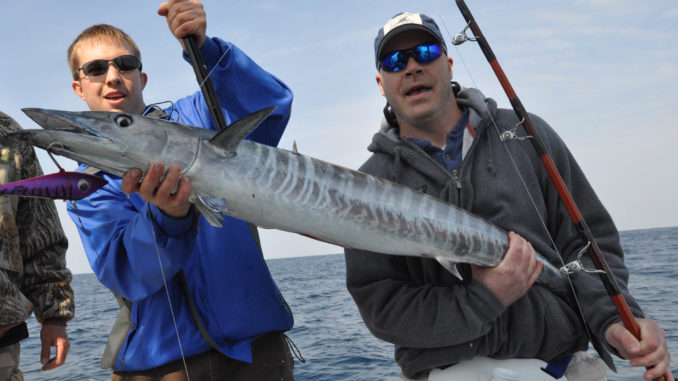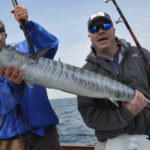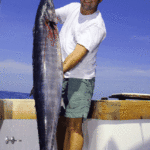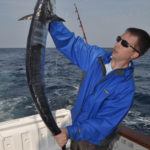
Cape Fear captains take full advantage of a great springtime run of these fast, aggressive fish. Here’s how to join them:
Capt. Butch Foster fired up the engines of Yeah Right, his 34-foot Chris Craft. On a chilly spring morning, his fishing party for the day was inside Southport Marina, drinking steaming cups of coffee.
The were all getting wired for wahoo.
Many fishermen haven’t recognized the potential for an early spring trip to the bluewater. If they did, they’d make a beeline to the coast, and the first big fish they’d likely encounter is a wahoo.
“Out in the Gulf Stream, it’s springtime all year,” Foster said. “If everyone knew how good the fishing can be, they’d come to the coast (now).”
A couple of hours later, Foster slowed down and started trolling in a zig-zagging pattern along a ledge known as the “Same Ole,” watching his depthinder for signs of baitfish and predators as he scanned the surface for birds diving on schools of cigar minnows or sardines.
“There are always other fish, like skipjack tuna and false albacore, around this time of year,” he said. “If you see them working the baitfish schools, you know the wahoo are going to be in the same area.”
A few false albacore and skipjack tuna attacked the trolled lures. Radio chatter told the story of wahoo landed and short strikes from fish that mangled ballyhoo baits but still got away. One captain radioed that he had landed four wahoo. It was a slow day.
“They’re being picky today,” Foster said. “It’s a great day to troll a plug instead of a ballyhoo.”
Chris Foster, the captain’s son and first mate aboard Yeah Right, had rigged a Yo-Zuri plug in favorite wahoo colors: purple and black. It went into a spread with skirted ballyhoos, some on outriggers, others on flatlines and a long line from the bridge rigged with a “Green Machine” that typically draws strikes from yellowfin tuna. The serious wahoo rigs, however, were on heavy planer rods with roller guides.
“We use No. 8 planers to get the lures down to the fish,” Chris Foster said. “You can rig just about anything on a planer rig that you can on a surface rod. Wahoo swim deeper than other fish. You might catch one on top every once in a while. But if you’re serious about catching some really big wahoo, your baits need to swim deep.”
The rod trolling the Yo-Zuri bent and bounced. The reel’s warning clicker ratcheted rapidly, telegraphing that a wahoo was streaking away. Chris Foster thrust the rod at one of the fishermen, stabbing the butt into a fighting belt. The fisherman, Stephen Nichols of Winston-Salem? What else could he do but hang on and yell, “Wahoo!”
Thevfight was on. After a few minutes of hanging onto the rod for dear life while the fish surged away with hundreds of yards of line, the angler won out. After long minutes of pumping and reeling, Nichols was relieved when Chris Foster removed the big planer from the line, and a few seconds later, Foster grabbed the leader. Leading the fish into position with one hand, he gaffed it with the other, then swung it aboard using both hands.
“That’s what makes getting up early and driving a long way worth the trip,” Nichols said. “I’d come that far for a wahoo, anytime.”
Another captain who specializes in catching spring wahoo is Carl Snow, who docks the Fish Witch II, a 44-foot Henriques sport fishing boat, at the Carolina Beach municipal docks.
“I’ve been fishing for wahoo about 52 years,” said Snow, 71. “We find the fish on the contour breaks. If you find a temperature break at the same, it’s just going to be so much the better.”
Snow fishes at the Adios, Black Jack, Steeples and other ledges along the Continental Shelf. He likes to see a temperature change of one-half to four degrees coinciding with one of his favorite ledges.
“I’m looking for 72- or 73-degree water for wahoo,” he said. “I fish in water from 160 to 350 feet deep and troll lures at depths of about 30 feet. I troll at about five knots.”
Snow also said he prefers the water to be rippled to rough. He doesn’t have the best success when the water surface is slick.
Wahoo are big fish, most weighing 25 to 40 pounds but some topping 100 pounds. Snow uses 80-pound class rods and 50W Penn International reels to subdue the big fish.
“You’re going to catch dolphin, yellowfin and blackfin tuna along with the wahoo,” he said. “When you get a few lures bit off, you know you’re going to have to switch to wire leader. I don’t switch all of my rods out with monofilament leaders, though, because I still want to catch the tuna. I always troll eight lines in the Gulf Stream so I keep at least four rods rigged with monofilament leaders.”
“Yellowfin tuna are leader shy,” Chris Foster said. “To catch them, we want to rig with as little wire in the spread as possible. When we use trolling skirts, we mostly rig them with heavy monofilament, and they get bit off sometimes when a wahoo strikes. Once that starts happening, we start switching over to wire leaders. When we use hard lures, we can get away with wire leaders a short as a foot long. Hard lures are less trouble to rig than skirts and ballyhoo, and wahoo seem to like them even better.”
For wahoo-specific rigging, Snow uses No. 7 to 9 single- strand, coffee-colored stainless steel wire leader. When he trolls a planer, he uses 50 feet of monofilament leader behind the planer followed by eight feet of wire leader, connecting the mono to the wire with an 80-pound Spro swivel. Depending upon the depth at which wahoo strikes are occurring, he uses planers from Nos 3 to 16 sizes, rigging it to the leader and line with a bridle so it can be removed quickly.
“I only use planers if the water isn’t too blue,” he said. “Earlier in the season, the water is green, and it’s darker, so the wahoo can’t see the planers. Later in the season, the water is clearer and turns blue. That’s when planers seem to scare the fish away.”
Snow’s planer rods are bent-butt or straight. They are placed at the stern of the boat, and the line to the planer is let out about 60 feet. The planer lines are fished closest to the boat because they are running the deepest. Lures and baits running on the flat lines and outrigger lines will troll above them and prevent tangles. With the planer trolling at about a 45-degree angle, it takes the lure down to about 30 of water depth. The depth the lure runs can vary depending upon size of the planer, speed of the boat, wave and wind direction, and current flow.
“When you gaff a wahoo, don’t try to get him in the box, because he’s a powerful fish,” Snow said. “Just get him inside the boat and watch out for his teeth, because they’re sharp. Once he calms down, you can remove the hooks with pliers, take a few photos and put him on ice. It’s always fun to catch a big wahoo, because he makes the reel scream and he’s so good to eat.”
DESTINATION INFORMATION
HOW TO GET THERE — Bluewater fishing out of ports in the Cape Fear area is excellent early in the spring. Southport, Wrightsville Beach and Carolina Beach are the best access areas. Public ramps are located in all three towns. Four good fishing holes along the Continental Shelf are the Same Ole (32 24 989N/77 04 659W), the Cape Fear Terrace (33 19 418N/77 22 331W), the Steeples (33 14 100N/77 18 750W) and the Black Jack Hole (33 11 140N/77 15 582W).. Look for temperature breaks along those ledges; they’ll hold baitfish and predators such as wahoo.
WHEN TO GO — Wahoo arrive off the Carolinas in good numbers in February, March and April. Their numbers diminish as the water warms; they make a good showing again in the fall as the water cools.
BEST LURES/TECHNIQUES — Trolling spreads with squid daisy-chain teasers, skirted lures rigged with ballyhoo and speed lures are the best bets for catching wahoo. When wahoo are in the area, planer rods and wire leaders can make or break the trip. A Pirate Plug Deep Six trolling lure with a ballyhoo digs below the surface where wahoo lurk. Good hard lures include the Yo-zuri Bonita and Braid Marauder. Excellent lure colors include pink/black, blue-white, purple/black.
FISHING INFO/GUIDES — Butch Foster, Yeah Right Charters, Southport, 910-845-2004; Carl Snow, Fish Witch Charters, 910-458-5855. See also GUIDES & CHARTERS in Classifieds.
ACCOMMODATIONS — Southport-Oak Island Chamber of Commerce, 910-457-6964, http://www.southport-oakisland.com/; Carolina Beach/Wrightsville Beach, Pleasure Island Chamber of Commerce, 910-313-6665 or http://www.pleasureislandnc.org/.
MAPS — Capt. Segull’s Nautical Charts, 888-473-4855, http://www.captainsegullcharts.com/; Maps Unique, 910-458-9923, www.mapsunique.com.








Be the first to comment